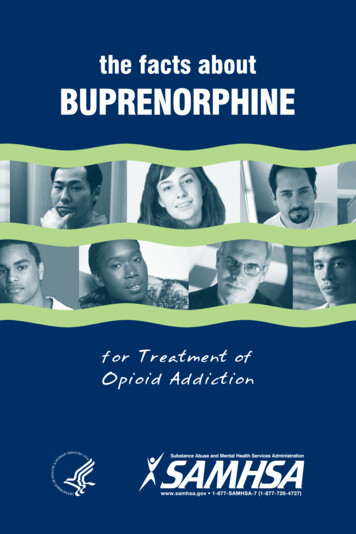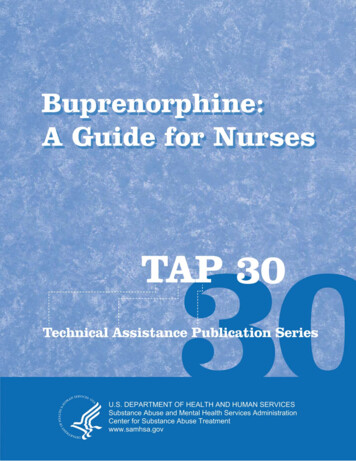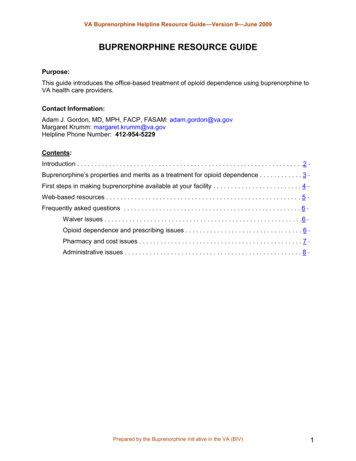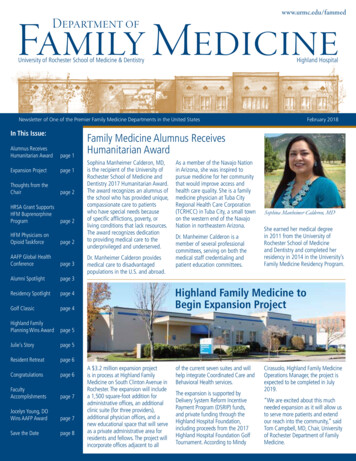
Transcription
the facts aboutBUPRENORPHINEfor Treatment ofOpioid Addictioni
“I’d been shot on the streets, I’d been indetox. It was jails, institutions . Death,I knew, was imminent for me so I startedmy recovery process . It’s been 15 yearssince, and my life has never been better.”Walston B.How do you escape from the misery and risks of drugaddiction? Most people cannot do it on their own. They needhelp to return to normal, healthy living. One important formof help is called medication-assisted treatment.There are three, equally important parts to this form oftreatment: Medication Counseling Support from family and friends.Buprenorphine is one type of medication used for treatmentof opioid addiction. Perhaps your doctor or substance abusetreatment provider has recommended it for you, or perhaps youalready take it. This booklet gives you the facts you need to know.NOTE: Important words often used in treatment areintroduced in this booklet in bold type.ii
Opioid addiction is a disease.Opioids are drugs that slow down the actions of the body, such asbreathing and heartbeat. Opioids also affect the brain to increasepleasant feelings. They get their name from opium, a drug madefrom the poppy plant.Opioid medications are prescribed to treat pain and sometimesfor other health problems such as severe coughing. Heroin is anillegal opioid that is smoked, snorted, or injected to get a goodfeeling, often called a “rush” or “high.” People also sometimesseek this feeling by taking large doses of prescription opioids.If you take opioids, you can become tolerant to them. Thismeans that more of the drug is needed to obtain its effects. Itis also possible to become dependent on opioids. This meansthat if you stop taking them, you will feel sick. This sickness iscalled withdrawal. Dependence is not the same as addiction,but sometimes dependence leads to addiction. The signs ofaddiction are: Craving—The mind develops an overwhelming desire forthe drug. Loss of control—It becomes harder to say no to using thedrug. Use is compulsive and continues even though the drugcauses harm.Tolerance and dependence are common side effects ofprescribed opioid medication that can be managed under adoctor’s care. Tolerance and dependence also are side effectsfrom misuse of opioids. Addiction is not likely to develop in aperson using medication properly, but this sometimes happens.Addiction usually occurs through misuse. Some people are athigher risk of addiction because of their genes, temperament,or personal situation.1
Not everyone who uses opioids gets addicted. But it is difficult tostop using opioids after you have become addicted, because thecravings are so strong and the fear of withdrawal is so great.Opioid addiction can be treated.Opioid addiction is a chronic disease, like heart disease ordiabetes. A chronic disease is a medical condition for life. Itcannot be cured, but it can be managed. A person with addictioncan regain a healthy, productive life.But if you are like most people, you cannot walk away fromaddiction on your own. Treatment—the care of medical professionals and substance abuse treatment providers—can help.Treatment helps you give up the problem drug. It helps you getthrough withdrawal and cope with cravings. Treatment alsohelps you change addictive thinking into nonaddictive, healthful patterns. It can help you move away from other harmfulbehaviors, too, such as drinking alcohol or abusing other drugsbesides the problem opioid.Just as important, treatment helps you address life issues youmight have that are tied to the addiction, such as feelings oflow self-worth, a bad situation at work or home, or spendingtime with people who use drugs. In short, treatment helps youmove into a healthy, addiction-free lifestyle—into a way of livingreferred to as recovery.Treatment may include medication.Medication-assisted treatment is treatment for addictionthat includes the use of medication along with counseling andother support. Treatment that includes medication is often thebest choice for opioid addiction.2
If you are addicted, medication allows you to regain a normalstate of mind, free of drug-induced highs and lows. It frees youfrom thinking all the time about the drug. It can reduce problems of withdrawal and craving. These changes can give you thechance you need to focus on the lifestyle changes that lead backto healthy living.Taking medication for opioid addiction is like taking medication tocontrol heart disease or diabetes. It is NOT the same as substituting one addictive drug for another. Used properly, the medication does NOT create a new addiction. It helps you manage youraddiction so that the benefits of recovery can be maintained.Buprenorphine is a medication usedto treat opioid addiction.Buprenorphine is one of three medications commonly used totreat opioid addiction. The other two are methadone and naltrexone. Cost varies for the different medications. You may needto take this into account when considering your treatment options.The person who takes buprenorphine feels normal, not high.However, the brain thinks it is receiving the problem opioid, sowithdrawal symptoms stay away. Buprenorphine also reducescravings. If cravings continue to be a problem, your doctor will adjust your medication or help you find other ways to reduce them.3
You take buprenorphine as a pill that dissolves under thetongue. You do NOT chew or swallow it. There are two forms.Suboxone contains buprenorphine plus another medicationcalled naloxone. The naloxone is added to prevent abuse—itbrings on withdrawal in people who abuse buprenorphine byinjecting it. Subutex contains only buprenorphine. This formis prescribed if you should not take naloxone for any reason,such as if you are allergic to it or are pregnant.The pill is taken once a day. Over time, the dose interval maystay at once a day or change to every other day.The main advantages of buprenorphine are: You are unlikely to overdose on buprenorphine if you take itproperly. Buprenorphine is long acting. This means that after an initialperiod, your doctor may have you take the pill every otherday rather than once a day. Doctors can prescribe buprenorphine so that you can take dosesat home. Important: Not all doctors have approval to prescribethis medication, and not all doctors provide counseling for addiction. Also, daily check-in at a treatment center can be helpful torecovery. Therefore, for some people, a treatment center is thebest place to receive medication for opioid addiction.Buprenorphine may be prescribed ifit is the right choice for you.Before you are given the first dose of any medication for opioidaddiction, your doctor will ask you questions about your addiction,health, and other problems. You will get a drug test—usually acheck of urine or saliva. You also will have a physical exam andtests for diseases that are common to people who have been44
abusing drugs. Your liver will be checked to make sure themedication can be safely taken. If buprenorphine is safe andappropriate for you, your doctor may recommend it.You and your doctor or substance abuse treatment providerdecide together on a treatment plan. The plan describes themedication routine, the counseling and other services that willbe provided, and the rules that must be followed. These ruleswill be explained to you and you will get them in writing.Buprenorphine must be used carefully.Your doctor will prescribe a low dose to start taking after withdrawal symptoms begin. Dose levels may be adjusted up asneeded. Always take doses exactly as prescribed by your doctor.Buprenorphine can make you feel drowsy at first. You should notdrive or perform other high-risk tasks until you know how thismedication affects you. If drowsiness continues to be a problem,your doctor may adjust dose levels.You may take buprenorphine for days, months, or years—aslong as it is needed to prevent relapse. However, you should bechecked often by a doctor if you have liver disease.If you are stable in recovery and want to stop taking buprenorphine,you must do it slowly, over time. This is called tapering. Taperingworks best with the help of your doctor or substance abuse treatment provider, after progress has been made in treatment.5
WARNINGS While taking this medication, you should NOT take othermedications without consulting your doctor first. While taking this medication, you should NOT use illegaldrugs, drink alcohol, or take sedatives, tranquilizers, or otherdrugs that slow breathing. Taking any of these substancesin large amounts along with buprenorphine can lead tooverdose or death. Buprenorphine kept at home must be locked in a safe placeto prevent accidental use by others, especially children. If you are a woman and are pregnant or breast-feeding,methadone is safer than buprenorphine for mother andchild. In special circumstances, doctors may recommend thenaloxone-free form of buprenorphine instead of methadone.Ask your doctor for more information. Liver problems are rare but can occur. If you have apre-existing liver condition, your doctor should conductregular tests on your liver.Buprenorphine has side effects insome people.Side effects are feelings of discomfort or sickness that comewith taking medicine. Buprenorphine has a few mild side effects.Usually these go away after the medication is taken for a while.If you have side effects, you should NOT stop taking the medication. Instead, talk with your doctor or substance abuse treatmentprovider. An adjustment in dosage or a change in medication mayhelp. There are some simple things you can do to reduce sideeffects, too.6
COMMON SIDE EFFECTSAND SIMPLE WAYS TO REDUCE THEMBody aches, headaches, and cold- or flu-like symptoms—Check with your doctor about over-the-countermedicines you may take.Dizziness—Stand up slowly. Call your doctor if problemspersist.Constipation—Drink more water and juice. Eat food withfiber. Exercise more.Sweating—Shower often. Dress in layers.Sleep problems, including tiredness—Take the pill in themorning. Avoid naps. Go to bed at the same time everynight. Exercise. Do not drink caffeine after lunchtime.Upset stomach or vomiting—Take the pill after you haveeaten. Take an antacid product as directed by your doctor.Mood swings—Exercise more. Do fun things that do notinvolve the old drug lifestyle. Relax. Talk to your substanceabuse treatment provider.Serious side effects—For extreme stomach pain, vomiting,or diarrhea, contact your doctor right away. Also seekhelp if the following side effects appear, because they mayindicate serious liver problems: Dark or tea-colored urine Bad stomachache Light-colored bowel movements Yellowing in the whites of the eyes Yellow skin.7
Counseling can help.Medication is one part of treatment for opioid addiction.For many people, another important part is counseling: theopportunity to talk with a professional either one-on-one orin a group with others in treatment.Through counseling, you learn about the motivations andbehaviors that led to your opioid addiction. You learn how tocommit to a more healthful lifestyle. You gain support and skillswhile working with others to manage your recovery long term.Counseling can provide you with encouragement and withmotivation to stick to treatment. It can help you learn how tomake healthy decisions, handle setbacks and stress, and moveforward with your life.In group counseling, you connect with others in treatmentand make new friends who don’t use drugs. You can get thesebenefits from support groups, too. These are informalmeetings of people facing similar challenges.88
Family and friends are important, too.It is very hard to go through recovery alone. Support fromfamily and friends is very important. Love and encouragementcan help you make the decision to enter treatment and stickwith it.Some treatment programs offer counseling for your loved ones.They do this because your addiction may have caused pain andanger or feelings of shame and hopelessness.Counseling is a useful way for family and friends to learn moreabout your situation, how to help, and how to handle theproblems your addiction has caused them. It is a safe place forthem to express feelings and to find out what help is availablefor everyone affected.There are support groups for family and friends, too. Theseare safe places to share information and encourage others whohave loved ones who are dealing with addiction.Many people with an opioid addiction regain normal, healthylives. One way they do this is with medication-assisted treatment. Medication, counseling, and support: together they canhelp you, your loved ones, and your friends.“The treatment center that I was at hada lot of education about addiction. Theytalked about it as a disease and not amoral failing . I had a medical condition .And that was a big relief for me to hearthat and to be able to realize that recoverywas possible.”Tom C.9
ADDICTIONWHAT’S TRUE AND WHAT’S NOTAddiction is a disease. It cannot be cured, but it canbe treated with medication, counseling, and supportfrom family and friends. Addiction is NOT a sign ofweakness. It is NOT TRUE that all you need to kickaddiction is to “be strong.”The FactsThe goal of medication-assisted treatment is torecover from addiction. It does NOT replace oneaddictive drug with another. It provides a safe, controlled level of medication to overcome the use of aproblem opioid.A substance abuse treatment provider mustobtain your informed consent (agreement inwriting) before sharing information about youwith others. There are two exceptions to thisprivacy rule: (1) if it appears that you may harmyourself or others and (2) if you have been orderedinto treatment by the courts. To learn more aboutyour privacy rights, talk to your substance abusetreatment provider.Recovery is possible. But it takes work. After treatment is finished, everything is NOT automatically fineagain. Recovery takes commitment every day, throughtreatment and beyond.10
BUPRENORPHINEWHAT’S TRUE AND WHAT’S NOTBuprenorphine helps you think and functionnormally. It is legal and taken under a doctor’s care.It is NOT just another drug to abuse.Buprenorphine is produced under safe conditions and sold legally. There is no risk of gettingtainted doses, which can happen with street drugs.Also, risk of overdose on this medication is very small.The FactsYou can stop taking buprenorphine when youare ready. You can become dependent on buprenorphine, as with many medications taken over time. Forthis reason, if you wish to stop taking buprenorphine,you should work with a substance abuse treatmentprovider to taper off. This prevents withdrawalsymptoms from appearing.11
Support groups and information This is not a complete list. Listing here does not mean thatthe Substance Abuse and Mental Health Services Administration (SAMHSA) endorses any of the organizations. Some support groups have abstinence-only policies and donot look favorably on medication-assisted treatment. Theprograms listed here do not have such policies, but individualgroup meetings vary. You may need to try several supportgroups to find the right one. Some support programs are just for people with a substanceuse disorder, and others allow families and friends to attendmeetings or have separate meetings for them. Check witheach organization for details. An Internet-based support group may be your best optionif no groups meet in your community. Another option is tocontact Alcoholics Anonymous (AA, http://www.aa.org) tofind out whether AA meetings in your community are opento people in recovery from other substances besides alcohol.Dual Recovery Anonymoushttp://www.draonline.org or 913-991-2702LifeRinghttp://lifering.org or 800-811-4142National Alliance of Advocates for BuprenorphineTreatmenthttp://www.naabt.orgRational Recoveryhttp://www.rational.org or 530-621-4374Secular Organizations for Sobrietyhttp://www.sossobriety.org/home.html or 323-666-42951212
SMART Recoveryhttp://www.smartrecovery.org or 866-951-5357Women for Sobriety, Inc.http://www.womenforsobriety.org or 215-536-8026Buprenorphine physicians andtreatment program locator800-662-HELP (4357) (English and Español)800-487-4889 TDD (for hearing impaired)http://buprenorphine.samhsa.gov/bwns locator/index.htmlFree booklets The Facts About Naltrexone for Treatment of OpioidAddiction (also in Spanish) Medication-Assisted Treatment for Opioid Addiction: Factsfor Families and Friends (also in Spanish) What Every Individual Needs To Know About MethadoneMaintenance Treatment: Introduction to Methadone Faces of Change: An Illustrated Booklet for Consumers What Is Substance Abuse Treatment? A Booklet for Families(also in Spanish) Motivation for Change: John’s Story–Consequences of HisHeavy Drinking and His Recovery (also in Spanish)Electronic access and printed copiesThis publication may be ordered or downloaded from SAMHSA’sPublications Ordering Web page at http://store.samhsa.gov.Or, please call SAMHSA at 1-877-SAMHSA-7 (1-877-726-4727)(English and Español).13
“What I’ve found in my life is thatthe more people I know that I tell thatI’m a person in recovery , then themore people will be able to carry thatmessage to their friends and familyand say, ‘Hey, I know somebody whodoesn’t use drugs anymore who usedto, and his life has gotten better.Maybe you can give this a try.’”—Dan P.ACKNOWLEDGMENTSThis publication was prepared for the Substance Abuse and Mental Health ServicesAdministration (SAMHSA) by the Knowledge Application Program (KAP), a Joint Ventureof The CDM Group, Inc., and JBS International, Inc., under contract number 270-047049, with SAMHSA, U.S. Department of Health and Human Services (HHS). ChristinaCurrier served as the Government Project Officer.All material appearing in this publication is in the public domain and may be reproducedor copied without permission from SAMHSA. Citation of the source is appreciated.However, this publication may not be reproduced or distributed for a fee withoutspecific written authorization from the Office of Communications, SAMHSA, HHS.This publication may be ordered or downloaded from SAMHSA’s Publications OrderingWeb page at http://store.samhsa.gov. Or, please call SAMHSA at 1-877-SAMHSA-7(1-877-726-4727) (English and Español).HHS Publication No. (SMA) 14-4442First Printed 2009Revised 2011 and 2014
breathing and heartbeat. Opioids also affect the brain to increase . pleasant feelings. They get their name from opium, a drug made from the poppy plant. Opioid medications are prescribed to treat pain and sometimes . for other health problems such as severe coughing. Heroin is an . illegal










